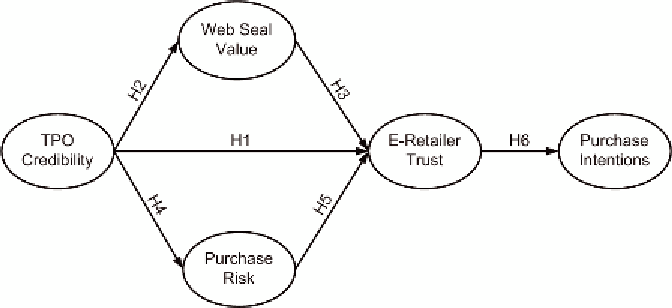Information Technology Reference
In-Depth Information
Figure 1. Proposed model
Apart from user traits, the antecedents to online
trust represent user perceptions upon review of
an e-retailer's Web site.
We utilize this framework to construct a model
in order to examine the relationship between
certain Web site characteristics (i.e., Web seals)
and users' perceptions of TPO credibility, Web
seal value, purchase risk, and trust. Furthermore,
as illustrated in Figure 1, we model behavioral
intentions to purchase from the e-retailer.
Research in the marketing literature shows
that third-party endorsements function similarly
to expert endorsements (Dean & Biswas, 2001).
Expert endorsements persuade through the
process of internalization whereby the receiver
adopts a certain attitude, either because it is use-
ful for problem solving or is demanded by the
receiver's value system (Friedman & Friedman,
1979). Research also relates the ability of expert
endorsements to change opinions (McGinnies &
Ward, 1980) and to positively influence purchase
intentions (Ohanian, 1991). E-retailers purchase
assurance services to reduce consumer uncer-
tainty, reduce risk perceptions, and persuade,
based on the credibility of the third party and
the services they provide. Thus, consumers that
regard the TPO as highly credible are likely to
have greater trust for the e-retailer.
H1: TPO credibility is positively related to trust
in the e-retailer.
TPO endorsements are regarded as value
signals that are significant in market transac-
tions (Dean & Biswas, 2001). In e-commerce,
Internet users initially are aware of a TPO assur-
ance provider by the presence of the TPO's Web
seal on the e-retailer's Web site. Internet users
implicitly assign value to a market signal when
they explicitly choose an unknown vendor with an
assurance seal over an unknown vendor without a
seal (Lala et al., 2002). Thus, Internet users likely
assign higher levels of value to seals from TPOs
that they consider highly credible, trustworthy,
or expert. In signaling research, signals tend to
be effective when the signaling firm maintains a
high reputation (Hoxmeier, 2000). Furthermore,
organizational credibility plays a role in influenc-
ing attitudes and purchase intentions (Goldsmith,
Lafferty, & Newell, 2000; Lafferty, Goldsmith,
& Newell, 2002) and is an important component
of reputation (Keller, 1998). Hence, the seal of a
credible TPO is likely to be more influential in an
online purchase decision. In contrast, the value of
a seal from a TPO with low perceived credibility
is not likely to be highly valued.

Search WWH ::

Custom Search